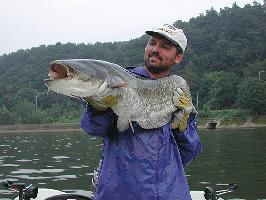
Biologická data
| Délka života | od 20 do 40 let |
|---|
Popis zvířete
The Wels catfish, scientifically named Silurus glanis, is a remarkable and imposing species of freshwater fish native to the vast expanses of Eurasia. From the serene waters of the United Kingdom and Spain, stretching across the continent to the enigmatic realms of Kazakhstan and Turkey, this species has established itself as a formidable presence in its aquatic domain. Its adaptability allows it to thrive in a variety of freshwater habitats, including large rivers, lakes, and reservoirs, showcasing its resilience and versatility as a species.Characterized by its sheer size, the Wels catfish is one of the largest freshwater fish in its region, with mature individuals commonly reaching lengths of 1.5 to 2 meters (5 to 6.5 feet). Exceptional specimens have been reported to surpass 2.5 meters (8.2 feet) and weigh over 150 kilograms (330 pounds), making it a behemoth among freshwater fish. The body of the Wels catfish is elongated and muscular, tapering to a slim, powerful tail that enables swift and agile movement through its aquatic environment. Its skin is smooth and scaleless, often dark in color, with shades ranging from greenish-black to brown, providing excellent camouflage in the murky waters of its habitat.
One of the most distinctive features of the Wels catfish is its broad, flat head and wide mouth, which is equipped with a formidable array of sharp, cone-shaped teeth. These teeth are perfectly adapted for its predatory lifestyle, enabling it to seize and hold onto its prey with remarkable efficiency. The fish also possesses a series of long barbels around its mouth, which serve as highly sensitive tactile organs, allowing it to detect the slightest movements in the water and locate prey even in complete darkness.
The diet of the Wels catfish is as diverse as its habitat, encompassing a wide range of prey items. It is an opportunistic predator, feeding on fish, crustaceans, and even small mammals and birds that venture too close to the water's edge. Its remarkable hunting strategy can involve solitary ambushes or cooperative hunting in groups, showcasing a level of social interaction and intelligence not commonly associated with fish.
Reproduction in Wels catfish takes place during the warmer months, typically from May to July, when water temperatures reach around 20°C (68°F). The female lays thousands of eggs in shallow, vegetated areas of the water body, which are then fertilized by the male. The eggs hatch in about three to ten days, depending on the temperature, giving rise to a new generation of catfish that will grow to continue the cycle of life in their aquatic realm.
In conclusion, the Wels catfish (Silurus glanis) is a fascinating and majestic creature that commands respect and admiration. Its impressive size, adaptability, and predatory prowess make it a keystone species in its ecosystem, playing a crucial role in maintaining the balance of its aquatic environment. As such, it is a subject of great interest not only to anglers and conservationists but also to anyone intrigued by the wonders of the natural world.
Nové fotografie zvířat
Top 10 zvířat
- Chinese water dragon (Physignathus cocincinus)
- Galápagos tortoise (Geochelone nigra complex)
- Dolphin gull (Leucophaeus scoresbii)
- Japanese macaque (Macaca fuscata)
- Colombian red howler (Alouatta seniculus)
- Sea urchins (Echinoidea)
- Moustached guenon (Cercopithecus cephus)
- Diana monkey (Cercopithecus diana)
- Common reed warbler (Acrocephalus scirpaceus)
- Common house mosquito (Culex pipiens)